Onion is an herbaceous biennial in the family Liliaceae grown for its edible bulb. A flattened disc forms the plant’s stem, and the tubular leaves overlap their sheaths to form a pseudostem. Three to eight leaves are present per plant, either erect or oblique. The bulb comprises several layers, each corresponding to a leaf. They are generally oval, but their shape can be variable and occur in clusters of 3 to 18 to a plant.
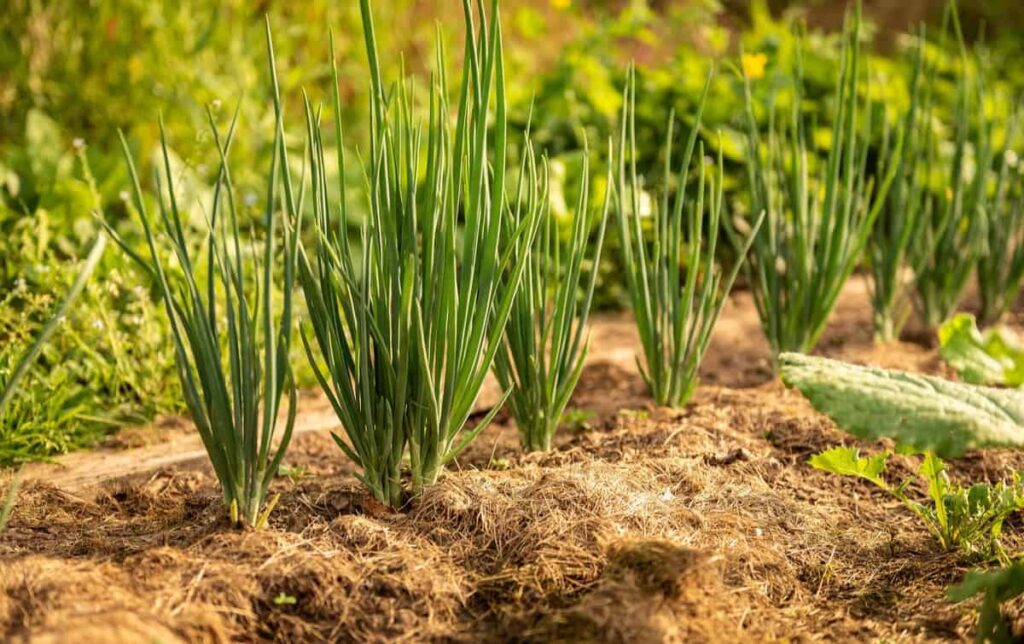
The bulb is protected by a membrane that turns into a paper coat. In addition to red and purple onions, shallots, and spring onions, onions can also be referred to by cultivars. There is no conclusive evidence of the onion’s origin, but it is likely to be in South East Asia, where the gene pool is the most diverse. To make better yields with high quality, keep an eye on the below-listed pests and diseases and their control methods.
How to control pests and diseases in Onion crop
Onion thrips
A typical feature of the adults is their elongated shape, greyish to yellow-brown color, and fringed wings. Usually, eggs are hidden in the tissue of leaves, petals, and stalks of crops. A larva of 0.5 mm is almost transparent-white or yellowish to orange-yellow. A second-stage larva measures about 1 mm in length. The prepupal and pupal stages can be found in the soil’s upper layers and on leaves, flowers, and other shelters. Their wing buds can identify Prepupa and pupa.
Damage symptoms
- Both adult and larval thrips feed within the mesophyll layer using a punch-and-suck motion.
- The beak and mandible are thrust forward to puncture the leaf epidermis, and sap released from injured plant cells is sucked up.
- Removal of chlorophyll causes the feeding area to appear white to silvery.
- Areas of leaf injury can occur as patches and streaks.
- When the feeding injury is severe, leaves take on a silvery cast and can wither.
- Tiny black “tar” spots of thrips excrement are evident on leaves with heavy feeding injury.
In case you missed it: How to Control Pests and Diseases in Tomato Crop: Causes, Symptoms, Chemical, and Biological Management
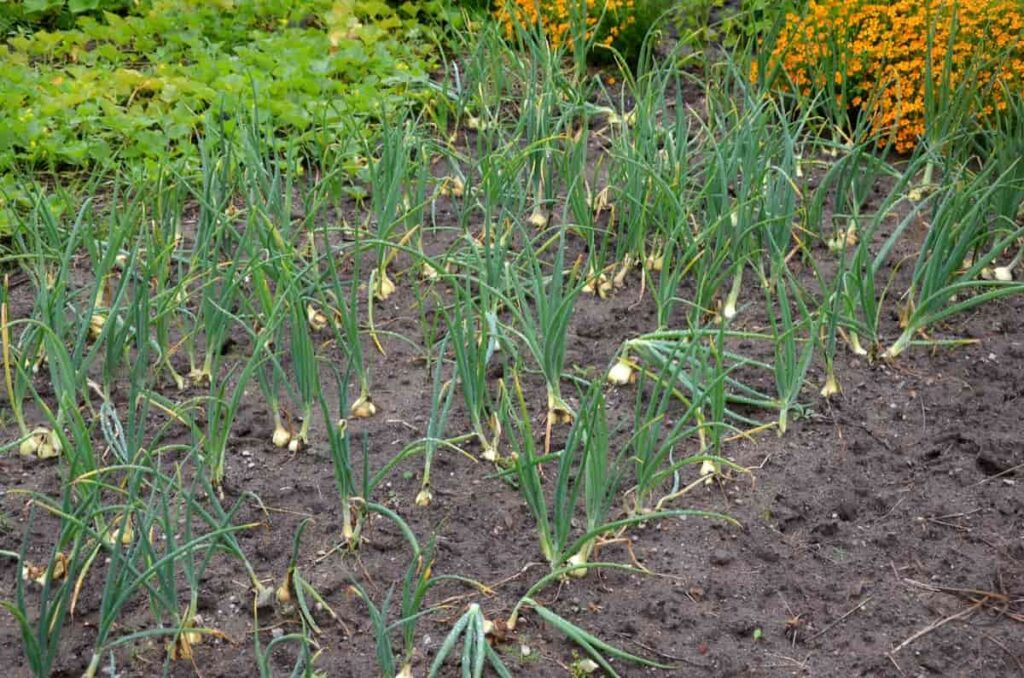
Biological control
- Grow resistant varieties viz., White Persian, Grano, Sweet Spanish, and Crystal Wax.
- Use neem-coated urea to reduce the infestation of the pest.
- Install sky-blue color sticky traps at 25 per hectare.
- Conserve and augment the natural enemies like parasitoids: Ceranisus menes (nymphs), and predators: predatory thrips, coccinellids, spiders, etc.
- Conserve predators like Scymnus nubilis, Orius albidipenis, Chrysopa sp, and predatory thrips vis., Aelothrips collartris
Chemical control
- Spray 625 ml of malathion 50 EC, methyl demeton 25 EC, dimethoate 30 EC, or monocrotophos 36 SL 500 to 750 ml in 500-750 L of water per ha as soon as the pest appears. A waiting period of 7 days should be observed before harvest.
- Foliar spray of insecticides like Profenofos (0.1%), Carbosulfan (0.2%), or Fipronil (0.1%), depending upon the severity of the infestation
Onion maggot
It is one of many flies known as “root maggots,” but it is the only one restricted to onions and Alliums. The adults of all species are small, grayish-brown flies that are difficult to distinguish from one another. The onion maggot is one of the largest root maggots, about 1/4 inch long and slightly smaller than a house fly. A typical maggot larva is creamy-colored, elongated, and pointed at the head end. Only microscopic characteristics can distinguish onion maggot larvae from other species.
Damage symptoms
- Only the larva causes damage by using its hooked mouth parts to enter the base of the plant.
- Damaged seedlings first wilt, eventually become flaccid, and die.
- Frequently, attacked seedlings die before the larvae are fully grown, forcing them to move to adjacent plants.
- Second-generation maggot feeding on developing bulbs usually results in distorted growth accompanied by rotting tissue.
- Feeding by third-generation maggots on late-season onion bulbs results in an unmarketable product
Chemical control
- Onion seed treatments with clothianidin, cyromazine, Fipronil, and spinosad effectively control this pest. Seed treatments offer several advantages, including alternative modes of action to chlorpyrifos and less active ingredient per unit area than in-furrow drench.
- In addition, a spinosad seed treatment provides organic growers with an effective insecticide option.
Biological control
- Naturally-occurring fungal diseases can significantly reduce onion maggot numbers when flies are plentiful, and relative humidity is high. Along field edges, dead, diseased flies can be seen clinging to the highest parts of plants during a fungal epidemic.
- Predaceous ground beetles that eat onion maggot eggs, larvae, and pupae can also reduce maggot numbers. However, because these soil-inhabiting beetles are susceptible to insecticides, broadcast soil insecticide treatments should be avoided whenever possible.
Chemical control
- Oil application products labeled for use against onion maggots
- Check the labels for specific crops allowed and other restrictions, including soil drench options for direct-seeded and transplanted crops.
- Ensure the insecticide penetrates the root zone using at least 100-200 gallons of water per acre after transplanting the seeds.
- Chlorpyrifos
- Diazinon
- Cyromazine
In case you missed it: Plant Pests and Diseases Identification: Symptoms, Causes, and Control Methods
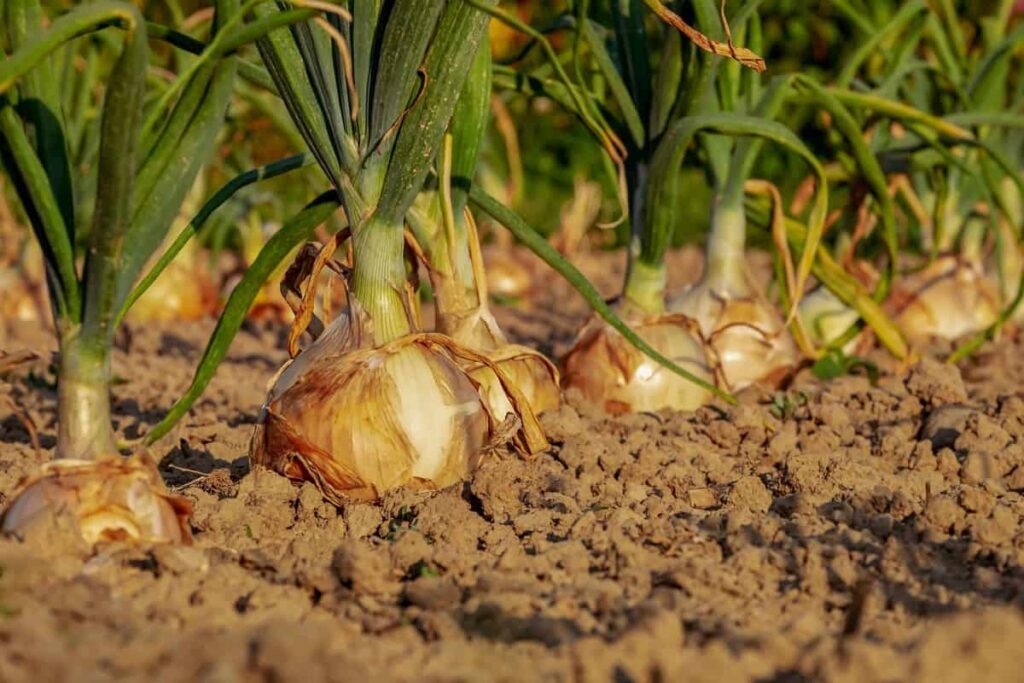
Red spider mite
The carmine spider mite typically completes a life cycle from egg to adult in about a week. All stages of this mite are present throughout the year. Reproduction is most likely to occur when the weather is hot and dry. Eggs are spherical, shiny, and straw-colored and hatch within three days. Single eggs are laid on the underside of leaves or attached to silken webs spun by adults. Three pairs of legs are on the larvae, slightly larger than the egg.
Damage symptoms
- Leaf undersides are the primary food source for adults and nymphs.
- Leaves become stippled with little punctures feeding punctures on their upper surfaces.
- Often, the mites feed near veins and midribs.
- The silk webbing produced by these mites is usually visible.
- Bleached and discolored leaves eventually fall off.
Biological control
- Spider mites have many natural predators, which limit their numbers, especially when undisturbed by pesticide sprays. Some of the important are the predatory mites, including the western predatory mite, Galendromus occidentalis, and Phytoseiulus mite species.
- Various other insects are also important predators, such as six spotted thrips.
- Lady beetle destroyed the larvae and adults of the spider mite.
- Natural predators, such as minute pirate bugs, big-eyed bugs, and lacewing larvae, will also effectively control these pests, including the cecidomyid Feltiella acarivora larvae.
- In addition, the western flower thrips, Frankliniella occidentalis, can be an important predator on spider mite eggs and larvae.
Chemical control
- Carbaryl, some organophosphates, and some pyrethroids also favor spider mites by increasing leaf nitrogen levels. Insecticides during hot weather usually cause dramatic spider mite outbreaks within a few days.
- In the case of mite infestations, selective materials such as insecticidal soaps and oils can be used. In addition, you can use petroleum-based horticultural and plant-based oils like neem, canola, and cottonseed.
- Many plant extracts are formulated as acaricides (pesticides that kill mites) that are effective against spider mites. The list includes garlic extracts, clove oils, mint oils, rosemary oils, and cinnamon oils.
- It is essential to cover the undersides of leaves with oil and soap. Repeat applications may be necessary.
Eriophyid mite
The life cycle comprises the egg, the larva, two nymphal stages (protonymph and deutonymph), and the adult. The egg incubation period is 2-4 days; Eggs are attached to fine silk webbing and hatch after approximately three days. Protonymphal and deutonymphal periods are 2 to 3 days each. Adult mites survive about eight days. The adult female can lay several hundred eggs during her life—a life cycle of 7 to 9 days. The temperature determines how long it takes for eggs to become adults.
Damage symptoms
- Both adults and immature feed on the young leaves and between the layers in bulbs of onion
- Their feeding causes stunting, twisting, curling, and discoloration of foliage and scarification and drying of bulb tissue
- This damage has been attributed to various viruses thought to be transmitted by the mites
Biological control
- During migration between plant tissues, the eriophyid mites are more exposed and vulnerable to natural controls such as predatory mites, mite destroyer lady beetles, cecidomyid larvae, and other predators. Therefore, avoid using broad-spectrum pesticides that may kill predatory mites and other natural enemies.
- Eriophyid mite populations often collapse due to natural enemies and possibly plant defense mechanisms (extra hairs on leaves or buds, thicker plant cell walls, or plant chemicals).
In case you missed it: How to Grow Cardamom (Elaichi) from Seeds at Home: Soil, Germination, Planting, Pests, Diseases, and Care
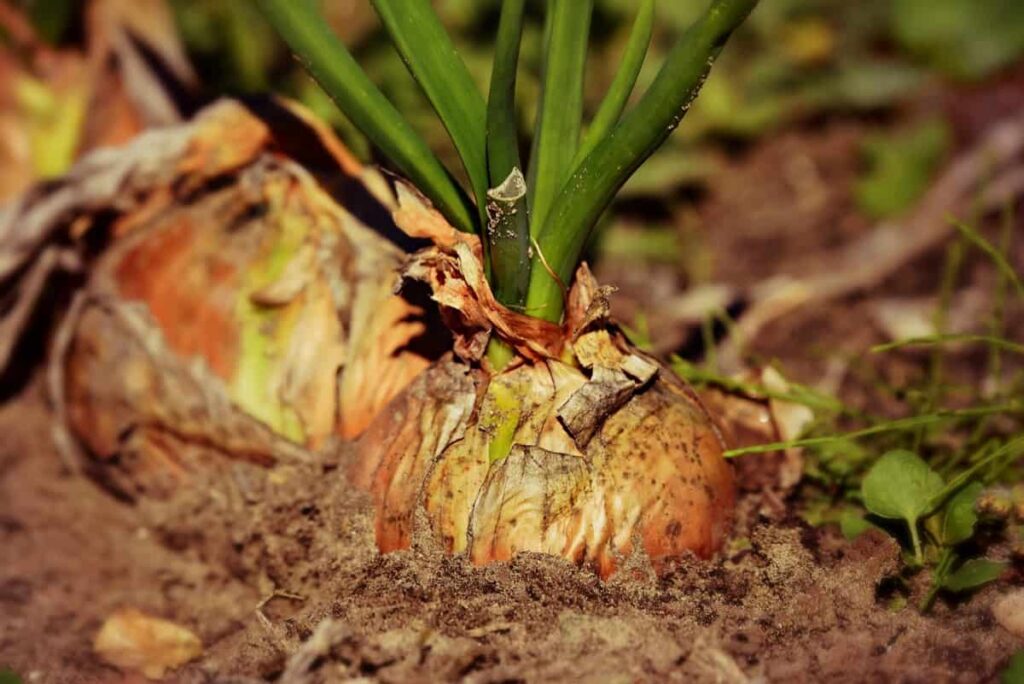
Chemical control
- As soon as the symptoms appear in the field, spray Dicofol (0.2%). If necessary, repeat the spray after 15 days.
- Foliar spray of sulfur at 0.05%
Diseases in onion farming
Damping off
The fungi that cause damping-off are usually common in an onion production field. These fungi generally survive for long periods in soil and may persist in plant debris or on the roots of weeds. The disease is more prevalent during Kharif or rainy seasons and causes about 60-75% damage. Damping-off tends to be most severe under high soil moisture and compaction conditions.
Disease symptoms
- Seeds and seedlings rot before emerging from the soil due to pre-emergence damping-off.
- In post-emergence damping-off, the pathogen attacks the collar region of seedlings on the soil’s surface. Seedlings collapse and die when the collar portion rots.
- The pathogen survives on infected crop debris and soil, a primary inoculum source.
Chemical control and management
- Healthy seeds should be selected for sowing to manage the disease.
- The seed should be treated with thiram at 2g/kg before sowing.
- Continuous raising of the nursery in a particular plot should be avoided. Instead, the topsoil of the nursery should be treated with thiram at 5 g/m² area and drenched with the same chemical at two g/litre of water at fortnightly intervals.
- The application of Trichoderma viride in the soil at 1,250 g/ha also effectively controls damping off considerably.
- Drenching the nursery beds with Captan or Thiram at 0.2% or Carbendazim at 0.1%, or Copper oxychloride at 0.3%
Purple blotch
Infection with purple blotch is caused by Alternaria porri, a fungus that can infect the entire ground surface and the bulb. Onions, garlic, and other allium crops are attacked by it. Spores are produced at night and released in the morning as humidity decreases and are spread by wind or splashing rain to healthy plants to initiate infection.
Warm and moist environmental conditions favor the pathogen. As a result, the pathogen overwinters in crop residue on or near the soil surface. The disease symptoms appear 1-4 days after infection, and new lesions produce black spores within five days.
Disease symptoms
- It appears as tiny, sunken, whitish flecks with purple centers on leaves and flower stalks.
- The lesions may encircle leaves or stalks and cause their drooping. The infected plants fail to develop bulbs
- Initially, small, elliptical lesions or spots often turn purplish-brown and are surrounded by a chlorotic margin.
- If the spots enlarge, the chlorotic margin extends above and below the lesion. Lesions usually girdle leaves, causing them to fall over. However, lesions may also start at the tips of older leaves.
Chemical control and management
Spray anyone of the below listed fungicides at 10-15 days intervals from 30 days after transplanting or once the disease appears.
| Sl. No. | Chemical compound |
| 1. | Mancozeb at 0.25% |
| 2. | Tricyclazole at 0.1% |
| 3. | Hexaconazole at 0.1% |
| 4. | Propiconazole @ 0.1% |
Stemphylium leaf blight
Stemphylium leaf blight (SLB), caused by Stemphylium vesicarium, is a foliar disease of onion worldwide. The disease causes small, tan to brown leaf lesions, rapidly progressing to defoliate plants. Crop loss occurs through a reduction in the photosynthetic area, causing smaller and reduced quality of bulbs and, indirectly, poor shelf and storage life.
In case you missed it: Custard Apple Diseases and Pests (Sugar Apple): Anthracnose, Black Canker, Diplodia Rot, Leaf Spot, Symptoms, Causes, and Prevention
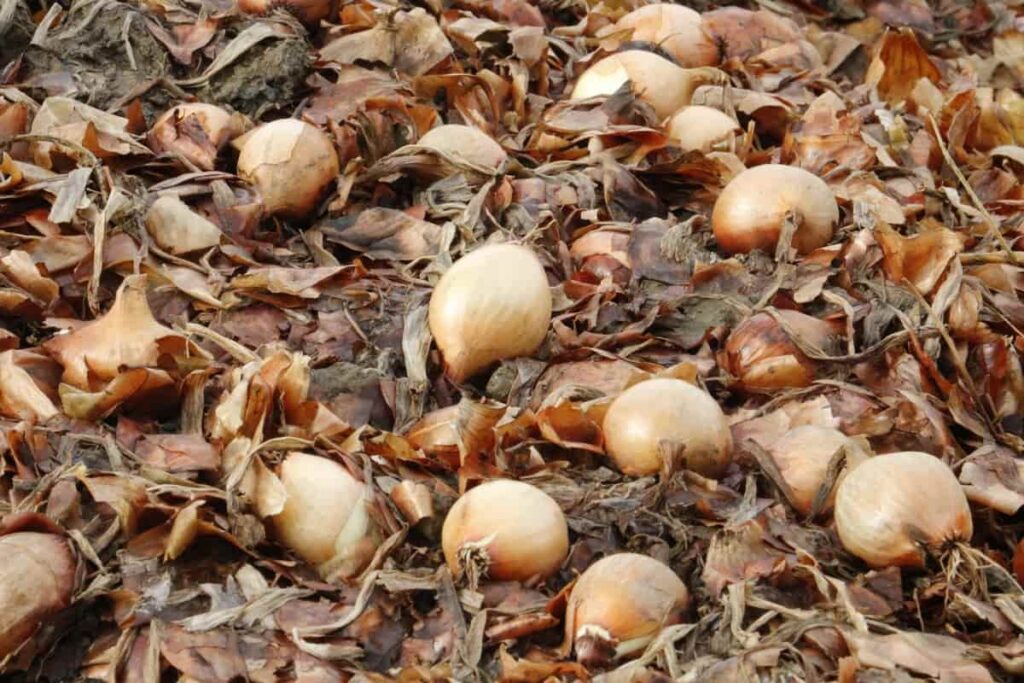
Damage symptoms
- In late March and early April, transplanted seedlings become infected on their radial leaves.
- Yellowish to orange flecks or streaks appear in the middle of leaves, which then develop into elongated spindle-shaped spots surrounded by pink margins.
- It causes severe damage to the seed crop when the disease attacks the inflorescence stalk.
- In this disease, the spots progress from the tip to the base of the leaves. Finally, the spots coalesce into extended patches, blighting the leaves and, gradually, the entire foliage.
Chemical control and management
Spay anyone of the below-listed fungicides at 10-15 days intervals from 30 days after transplanting or once the disease symptoms appear
| Sl. No. | Chemical compound |
| 1. | Mancozeb at 0.25% |
| 2. | Tricyclazole at 0.1% |
| 3. | Hexaconazole at 0.1% |
| 4. | Propiconazole at 0.1% |
Anthracnose
Onion anthracnose, also known as onion smudge, is a worldwide threat. Three different Colletotrichum species cause the disease. Anthracnose can infect dried scales, bulbs, and leaves of onion plants. Lesions develop on the bulbs, and leaves become very distorted and chlorotic. This disease can be managed with protectant fungicides and sound cultural practices.
Damage symptom
- The symptoms initially appear on the leaves as water-soaked pale yellow spots spread lengthwise, covering the entire leaf blade.
- The characteristic symptoms are curling, twisting, chlorosis of the leaves, and abnormal neck elongation (false stem).
- Initially, pale yellow water-soaked oval sunken lesions appear on leaf blades. Then, numerous black-colored, slightly raised structures are produced in the central portion, which may be arranged in concentric rings. Next, the affected leaves shrivel, droop down and finally wither.
Chemical control and management
- Soil treatment with Benomyl at 0.2%
- Foliar Spray of Mancozeb at 0.25%
- Planting onion on the raised bed
- Avoid waterlogging
Black mold
Black mold is primarily a postharvest condition. It occurs in onions and garlic but is more of a concern in onion crops. Black mold occurs most commonly when onions or garlic are grown under warm conditions. For the disease to develop on the bulb, moisture must be present for six to twelve hours. During storage or when bulbs come out of storage, condensation can accumulate between the outer dry scales of bulbs. It is a weak pathogen that generally does not affect bulbs that are not damaged by decaying organic matter.
Disease symptoms
- Upon maturation, infection is usually through neck tissue.
- Bulb scales that are infected become shriveled and discolored black around the neck.
- The outer dry scales become covered with streaks of powdery black spores.
- The infection may spread into the fleshy scales of the neck.
Chemical control and management
- Store and transport bulbs at temperatures below 15°C and low humidity to slow the growth of the fungus.
- Onions should be harvested promptly and dried as soon as possible. Drying should not be done with heated air.
- Black mold can grow on bulbs and between the outer dry scales when there are wide temperature fluctuations.
Chemical sprays
Carbendazim 50 WP. Bitertanol 10 WP, Hexaconozole 5 EC, Mancozeb 75 WP, Captan 50 WP, Zineb 75 WP
Bacterial brown rot
bulb rot of onion has great destructive potential to cause significant economic losses to onion production due to foliage damage and bulb decay in the field and during storage. These diseases are primarily a problem with onions. Water is essential for the entry and spread of bacteria. Bacteria enter the bulb through wounds and dying lower leaves. The pathogens are soilborne and may extend through irrigation water or splashing water from rain or irrigation. These pathogens are favored by warm temperatures (over 29.5°C) and wet conditions.
Disease symptoms
- Field symptoms often appear as one or two wilted leaves in the center of the leaf cluster. These leaves eventually turn pale yellow and die back from the tip, while older and younger leaves maintain a healthy green appearance.
- During the early stages of this disease, the bulbs may appear healthy except for a softening of the neck tissue.
- The disease progresses from the top of the infected scale to the base
- Eventually, all the internal tissue will rot. Finally, the internal scales dry, and the bulb shrivels.
- Squeezing the base of infected plants causes the rotted inner portion of the bulbs to slide out through the neck, hence the name slippery skin.
In case you missed it: Bottle Gourd Pests, Diseases (Lauki), Control
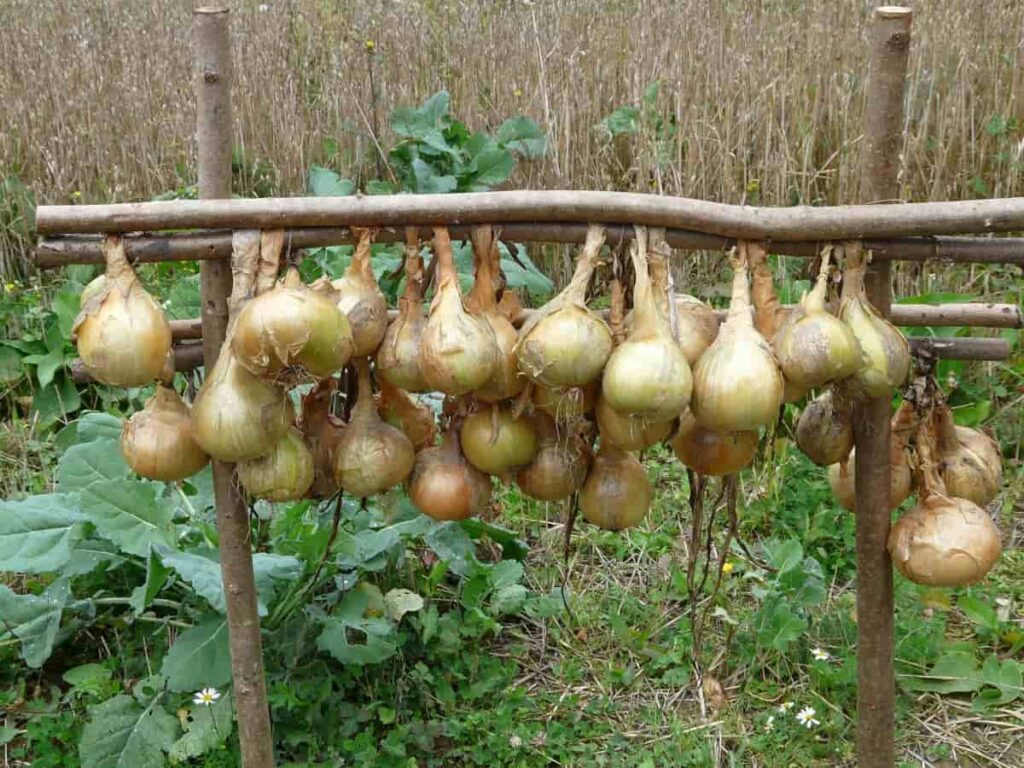
Chemical control management
- Proper curing is required before storage. Use maleic hydrazide and isopropyl phenyl carbamate (IPC) at 20 ml/liter before one month of harvest.
- Neck cutting is about 2.5-3.0 cm. long above the bulb is reduced bacterial infection. Light irrigation is required during the entire cropping period.
Conclusion
Onions are prone to several different diseases, especially in wet growing seasons. These often get started on their leaves and, if severe, can reduce bulb growth and yield. Therefore, if you plan to cultivate onions, have a good knowledge of symptoms due to the above-discussed pests and diseases and their control methods.
- Organic Gardening on a Budget: Low-Cost Methods and Materials
- Gongura Seed Germination and Planting Methods
- Cabbage Seed Germination and Selection
- Broccoli Seed Germination and Selection
- Asparagus Seed Germination and Variety Selection
- Seasonal Flower Gardening: Best Practices for Spring, Summer, Fall, and Winter
- How to Grow Hibiscus from Flower
- Plantation Ideas for Home Decoration: A Beginners Guide
- Flower Garden Designs and Layouts for Beginners
- Planting and Spacing Techniques in Papaya: A Beginner’s Guide
- Growing Gold: Essential Techniques for Planting Pineapples
- How to Make Kalanchoe Plant Bushy: Home Remedies and Solutions
- 11 Reasons Why Your Gardenia is Not Blooming: Home Remedies and Solutions
- Eco Elegance: The Guide to Designing a Drought-Tolerant Landscape
- Gardening on a Slope: Strategies for Hillside Landscaping
- Nourish and Flourish: Top Organic Mulches for Thriving House Plants
- Everything You Want to Know about Indian Mogra Flower: Discover Uses and Growing
- Green Thumb Success: Expert Tips for Cultivating Greenhouse Pumpkins All Year Round
- Maximize Growth & Flavor: The Ultimate Guide to Companion Planting in Herb Gardens
- How to Control Rhododendron Problems Naturally: Home Remedies and Organic Ways to Fix Them
- Natural Magic: The Remarkable Benefits of Cinnamon for Plants
- Best Steps to Revive Dying Tulip with Natural and Organic Treatment
- 10 Reasons Why Your Angel Trumpet is Not Blooming: Remedies and Treatment
- How to Fix Periwinkle Leaf and Flower-Related Problems: Natural Remedies and Solutions
- How to Fix Zinnias Leaf and Flower Problems: Discover Natural and Home Remedies
- Organic Steps to Induce Lemon Tree Flowers: A Comprehensive Guide
- Bloom Booster: Crafting the Perfect Homemade Bougainvillea Fertilizer
- Optimizing Growth: A Guide to Applying NPK Fertilizer for Potted Plants
- 10 Best Homemade Fertilizers for Rubber Plant: DIY Recipes and Application Method
- How to Boost Female Pumpkin Flowers: Effective Steps for More Flowers and High Yields
- Transform Your Indoor Garden: Top Benefits of Pink Salt for Houseplants
- 10 Best Homemade Fertilizers for Peacock Plants (Calathea): Easy DIY Guide
- Unlock Blooms: 9 Reasons Why Your Potted Chrysanthemum is Not Blooming
- 8 Reasons Why Your Potted Hibiscus is Not Blooming: Fix it with Simple Solutions
- Unlock Blooms: 9 Key Reasons Your Potted Frangipani Won’t Flower
- 10 Reasons Why Is My Ice Plant Not Blooming: Remedies and Treatment